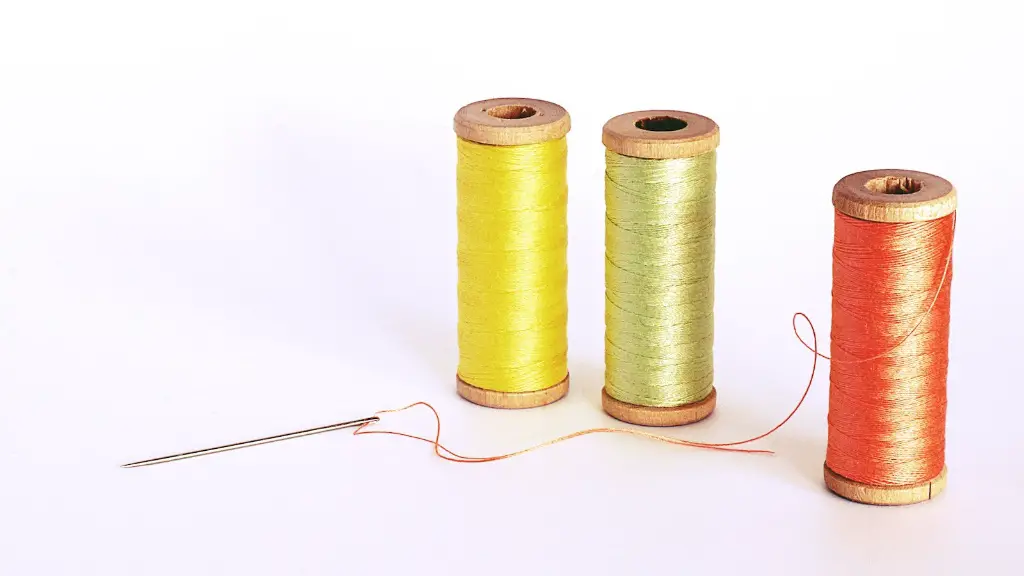Have you ever stopped to wonder when the sewing machine was invented? This simple device has been used for countless sewing projects, from garment making to quilting. It has been present in households for generations, and is still used today. But when was it invented?
The invention of the sewing machine is credited to French tailor Barthelemy Thimonnier. He was born in 1793, and after an expensive apprenticeship as a tailor, he decided to dedicate his life to find a more efficient way to stitch clothing. At the time, tailors were using a primitive form of needle and thread that was laborious and time consuming. So, Thimonnier came up with the idea to invent a machine using a needle, thread, and presser foot to quickly produce stitches.
In 1829, Thimonnier created the first functional foot powered single-thread chain-stitch machine. Thimonnier was likely motivated to invent the sewing machine due to his experiences during the Napoleonic wars, where he saw the need for efficient production of large volumes of uniforms.
The two key components of his invention were the eye-pointed needle and the shuttle, both of which allowed the machine to create a continuous stitch. The shuttle moved back and forth in the fabric, taking a looped thread through the fabric as the wheel that powered the machine turned. This allowed a large amount of stitching to be done in a short period of time.
The invention was highly revolutionary, as it allowed rapid production of clothes. However, despite the great potential of the invention, it was not well received by the tailors of the time. Tailors saw the invention as a threat to their livelihoods and some of them even attacked the workshop where Thimonnier’s machines were produced, destroying all the machines in sight.
This setback meant that Thimonnier’s invention was not adopted and it would be some time until a better sewing machine was invented. But Thimonnier should be credited for his pioneering work, as it kicked off the evolution of the modern-day sewing machine.
The next major step in the evolution of the sewing machine came in the 1850s, when American inventor Isaac Singer developed a more reliable machine. Singer used a pedal driven machine with an up-and-down needle to power stitch production. This was much faster than Thimonnier’s machine and it provided the foundation for the modern-day sewing machines.
Different Types of Sewing Machines
Over the years, sewing machines have been constantly refined and improved, with the machines of today providing great versatility while being easy to use. The two main types of sewing machines are the mechanical and electronic sewing machines. Mechanical machines are manual and use levers and dials to control the stitches, while electronic machines are powered by motors and provide more features and control.
Basic mechanical sewing machines are great for basic tasks such as mending and hemming. Advanced machines provide more features, such as multiple stitches and adjustable stitch lengths for more creative projects. Electronic machines have the same range of capabilities, and feature automated functions such as computerized needle threading, speed controls, and pattern selections. In addition to these, some newer models also have LCD touchscreens and USB ports for downloading patterns from a computer.
High-end models of sewing machines provide even more features, such as threads that are cut automatically, quilting capabilities, and embroidery stitches. These machines tend to be more expensive, but they can make detailed and complex projects much easier to execute.
Advantages of Sewing Machines
Aside from convenience, sewing machines offer many advantages. The speed and efficiency of sewing machines can make the task of sewing much faster and easier, especially for large projects. It also helps reduce fatigue, as the machine does much of the work that would otherwise have to be done with a needle and thread.
Sewing machines also offer a much wider range of stitches than can be achieved by hand. For example, some machines can produce decorative stitches, overlock stitches, and even embroidery. This flexibility makes them great for making intricate and detailed designs.
Finally, sewing machines also offer convenience and portability. Most sewing machines come with a carrying case which makes it easy to take them anywhere. This makes them great tools for taking on the go or teaching a hobby or skill.
Care and Maintenance
Despite their advantages, sewing machines also require special care and maintenance in order to work reliably. One of the most important things to do is keep the machine clean. Lint and dust can accumulate inside the machine and interfere with the movement of the parts, so it is important to regularly vacuum or brush out the machine. It is also important to oil the machine as needed to keep the parts moving smoothly.
It is also important to keep the machine in a place where it is not exposed to extreme temperatures or moisture. Extreme temperatures can damage sensitive electronics and cause the machine to malfunction. Moisture can also cause rust, which can damage the machine.
Finally, regular use of the sewing machine can cause it to wear out over time. It is important to replace worn parts, such as gaskets and needles when necessary. In some cases, it may also be necessary to send the machine in for maintenance or repair.
Conclusion
Today, sewing machines are ubiquitous in households around the world. These machines provide a wide range of features and capabilities, making them great tools for both everyday tasks and creative projects. The invention of the sewing machine has greatly improved the efficiency of many sewing tasks, and is a testament to how far we have come in terms of technology.



